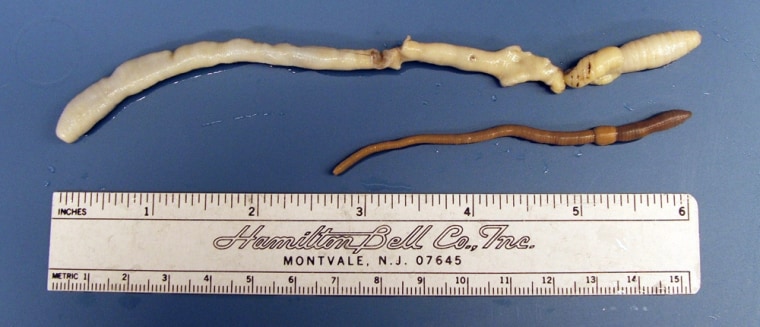It's 3 feet long, pinkish in color, smells like a lily and must be saved from extinction, conservationists said Thursday in asking the federal government to protect the Giant Palouse Earthworm under the Endangered Species Act.
Long thought extinct, the worm was rediscovered in the past year to occupy tiny swatches of the heavily farmed Palouse region along the Washington-Idaho border.
"This worm is the stuff that legends and fairy tales are made of," worm supporter Steve Paulson declared. "What kid wouldn't want to play with a 3 foot-long, lily smelling, soft pink worm that spits?"
The U.S. Fish and Wildlife Service has not yet seen the petition regarding Driloleirus americanus, agency spokesman Tom Buckley said in Spokane.
Normally when the agency gets a request, it will consider whether an emergency listing is needed. Then it will do a 90-day review to determine if the issue warrants additional study, Buckley said.
If it deserves more study, there will be a year long review to decide if endangered species protection is needed, Buckley said.
"When you consider how the Palouse prairie has been utilized, with all the agriculture down there, how anything like that survived the effects of agriculture is beyond me," Buckley said.
He can also see other reasons the worm might need protection.
"If you are a fisherman, it might be a bonanza if you found something like that," Buckley said.
The petition was sent by certified letter on Aug. 30 to Interior Secretary Dirk Kempthorne, a former Idaho governor, said Paulson, an author of the petition who lives in Lenore, Idaho.
It's too soon to know if anyone will object to the listing, or what lands might be considered critical habitat, Paulson said. He suspected that only lands that have not been developed, which represent only a fraction of 1 percent of the Palouse prairie, would be preserved as habitat.
The earthworm is native to the deep soils of the Palouse, which were built up by millions of years of volcanic ash and are some of the richest farmland on Earth. Little is known about the giant worms: how many there are, where they live, how they behave, or why they are so scarce.
The worm was first found in 1897, and the species has always been elusive. It can burrow down to 15 feet deep. There have been only three reported sightings since 1987.
The most recent was on May 27, 2005, when a graduate student from the University of Idaho, Yaniria Sanchez-de Leon, unearthed one specimen.
The Giant Palouse Earthworm is described as the largest and longest-lived earthworm on this continent. It reportedly gives off a peculiar flowery smell when handled, and can spit at attackers, Paulson said.
Groups signing the petition are the Palouse Prairie Foundation, Palouse Audubon Society, and the Friends of the Clearwater.
Locals are belatedly trying to save the last remnants of the undeveloped Palouse prairie, and the earthworm could play a major role in that.
"Listing the Giant Palouse Earthworm may be the only salvation for the Palouse Prairie," said O. Lynne Nelson, who signed the petition.
